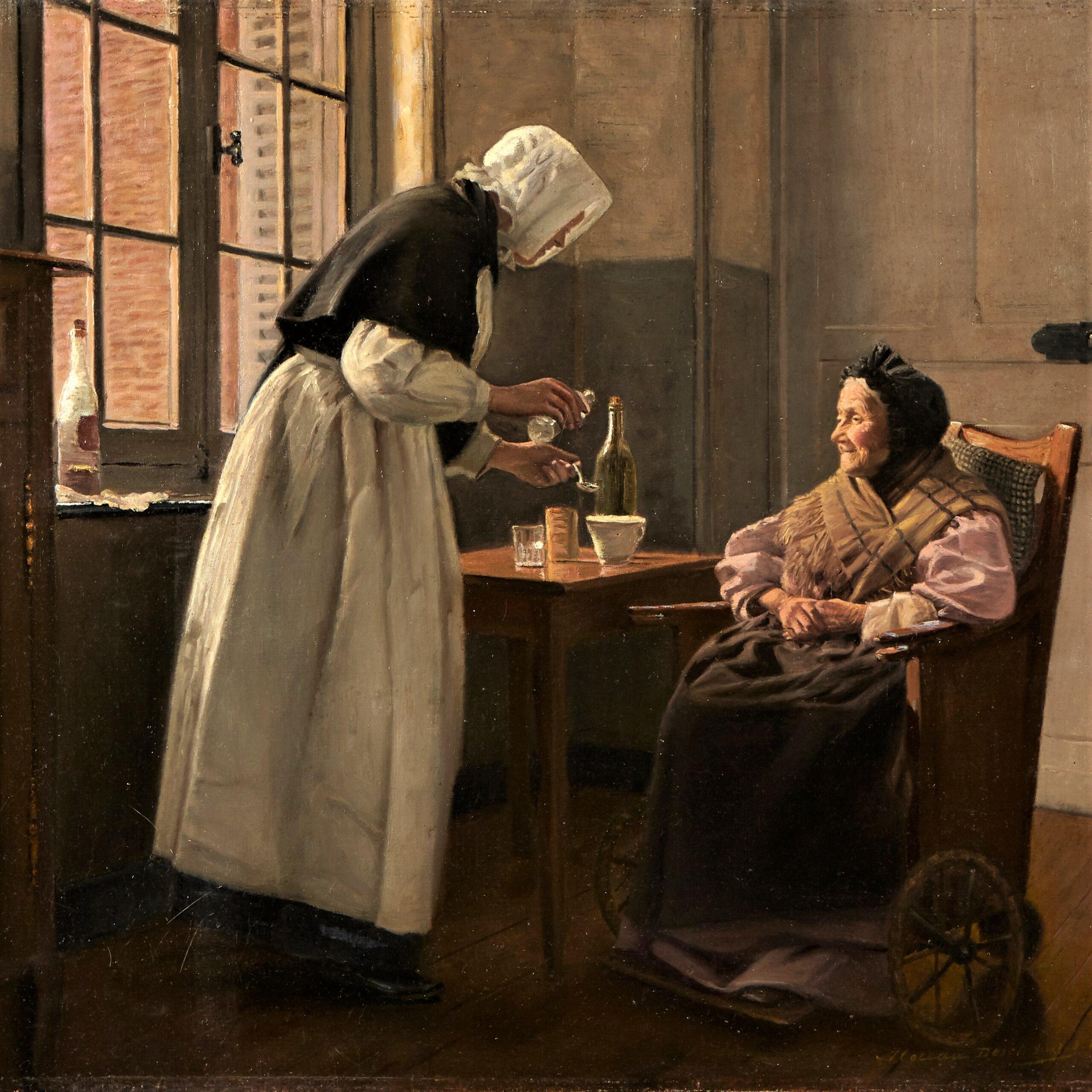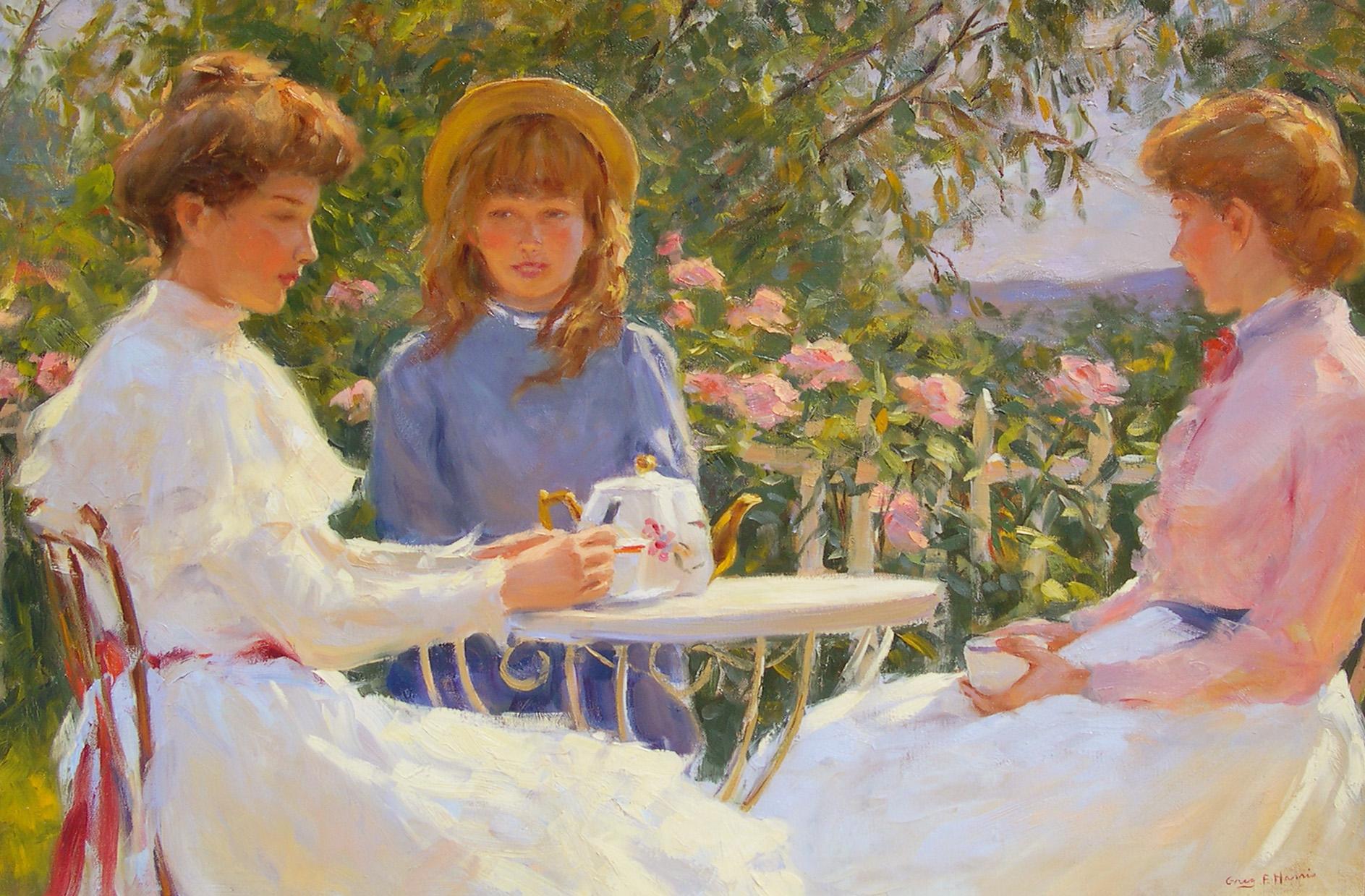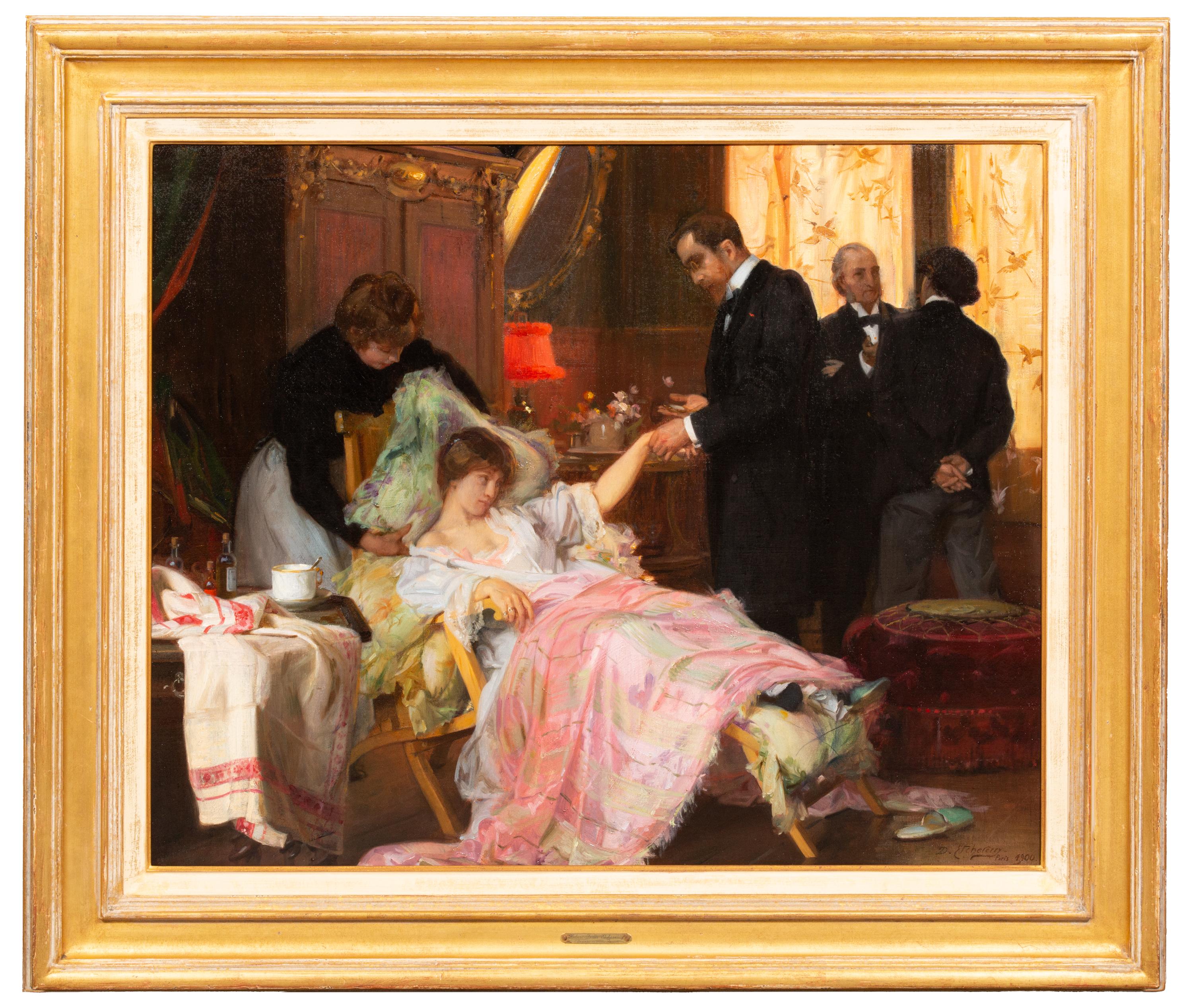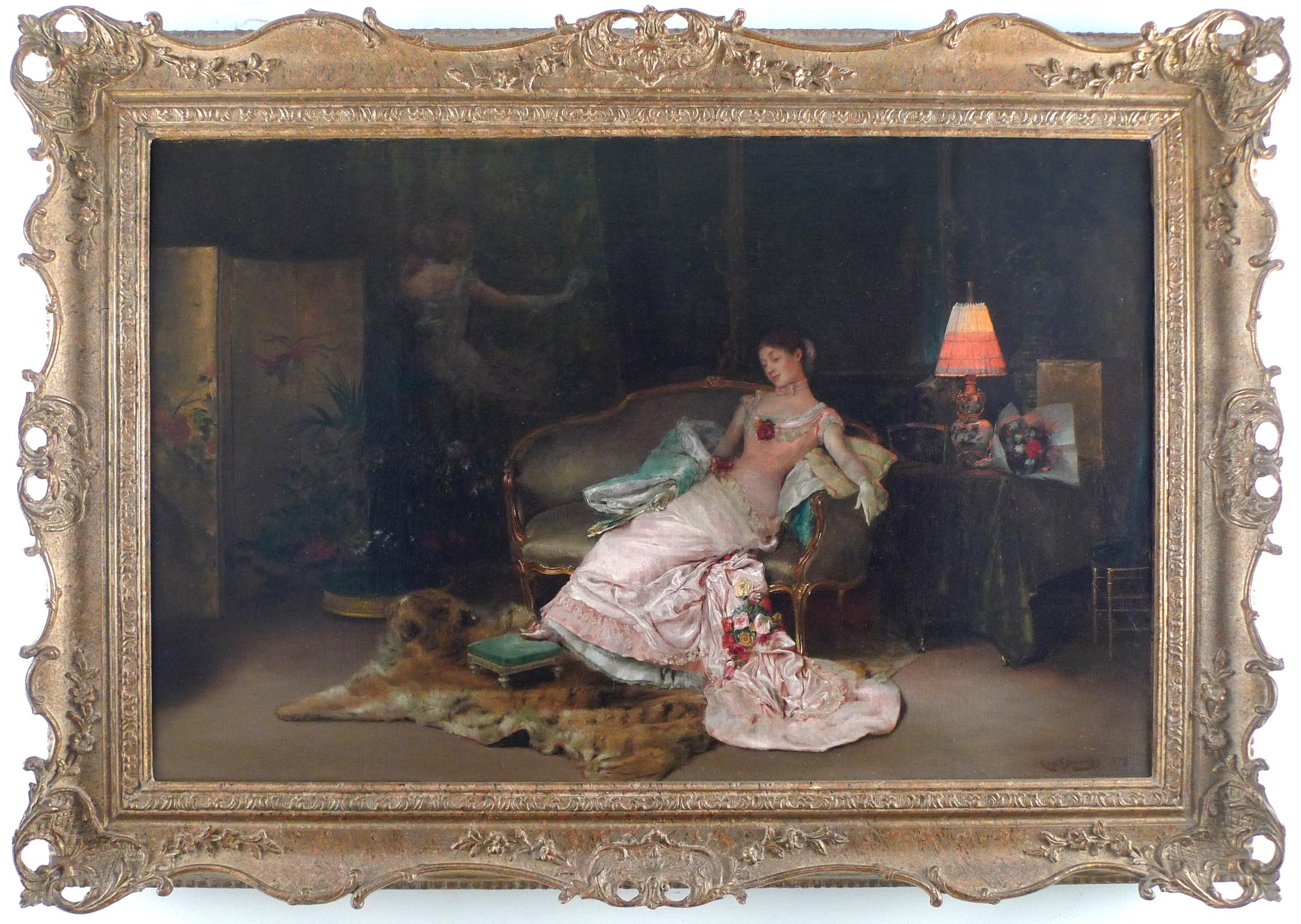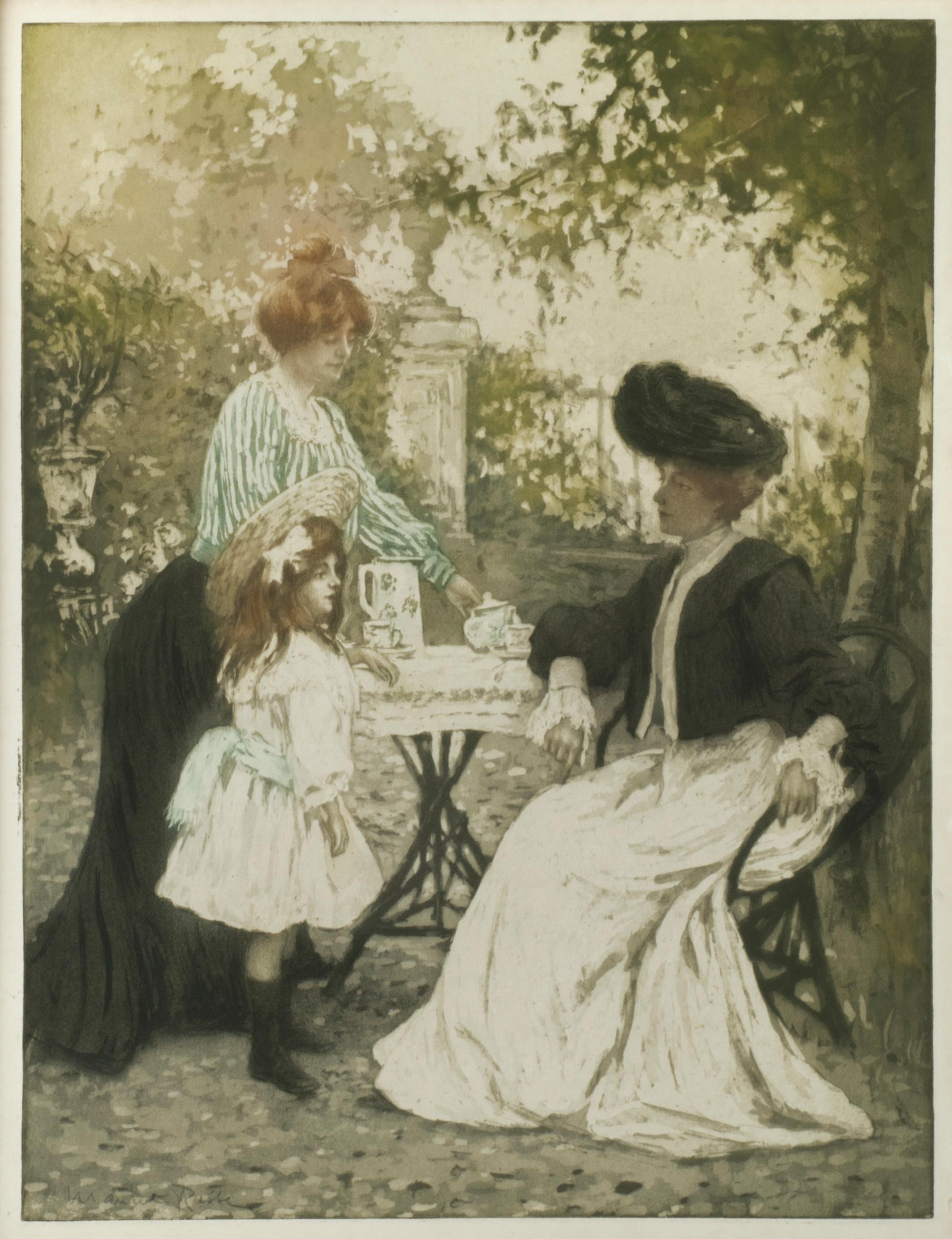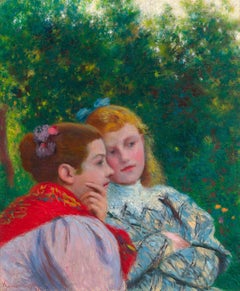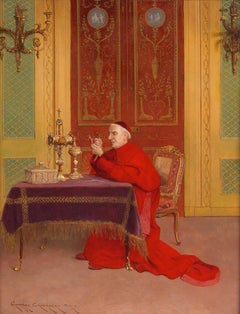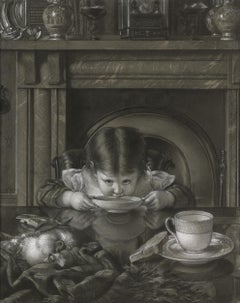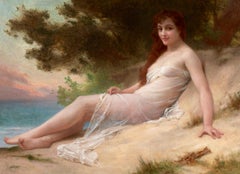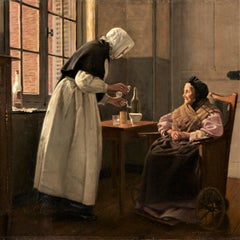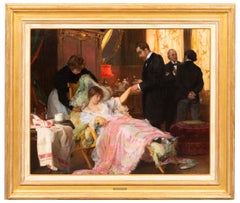Items Similar to Afternoon Tea by Charles-Joseph-Frédéric Soulacroix
Want more images or videos?
Request additional images or videos from the seller
1 of 8
Charles-Joseph-Frédéric SoulacroixAfternoon Tea by Charles-Joseph-Frédéric Soulacroix19th Century
19th Century
$124,500
£94,332.36
€108,238.91
CA$175,191.59
A$192,583.76
CHF 101,213.19
MX$2,338,668.29
NOK 1,262,609.12
SEK 1,196,233.35
DKK 807,814.38
About the Item
Charles-Joseph-Frédéric Soulacroix
1825-1879 French
Afternoon Tea
Oil on canvas
Signed "F. Soulacroix" (lower right)
A charming trio sits down for afternoon tea in this enchanting work by renowned costume painter Charles-Joseph-Frédéric Soulacroix. A master at depicting the silks and satins so popular among the fashionable elite of his age, Soulacroix has attired his coquettish young ladies in gowns that shimmer with realistic, intricate detail. The intimacy of the tableau and the extravagant surroundings make this enchanting oil on canvas all the more enticing.
A superb record of the lives of the affluent French elite, Soulacroix's costumed figures embody the elegance and luxury of the most fashionable French salons. Soulacroix was arguably the most famous and accomplished painter of this idealized genre, referred to as the “Silk and Satins School” of the costume painters. Few could match the remarkable level of detail and realism he imparted onto each sumptuous canvas. In the present example, the gleaming folds of the ladies’ gowns appear smooth to the touch, and one can almost feel the many other lush textures of their opulent environment.
Best known for his scenes of wealthy 18th-century figures, Soulacroix was undoubtedly the most famous and talented painter of his genre. He began studying art at the age of 25 at the esteemed École des Beaux-Arts in Paris and started exhibiting his works just four years later at the Paris Salon. Though he painted many historical scenes, it is his depictions of affluent French families in Napoleonic-era costumes that are his most popular among avid art collectors. He is touted for superbly recording the lives of the wealthy in their everyday luxurious pursuits—from taking tea to playing hide-and-seek, and from debuting at a ball to tending to a pet. He combined fantasy with reality, sensuality with sensibility and, above all, infused his compositions with an aura of luxury and sophistication.
19th century
Canvas: 32” high x 24 1/4” wide (84.14 x 63.82 cm)
Frame: 40 1/2" high x 32 1/4" wide (106.68 x 85.73 x 9.53 cm)
Provenance:
Collection of Lillian Piscantor, Sacramento, California
Private collection, Mississippi
Private collection, United Kingdom
M.S. Rau Antiques, New Orleans
Private collection, Texas
- Creator:Charles-Joseph-Frédéric Soulacroix
- Creation Year:19th Century
- Dimensions:Height: 42 in (106.68 cm)Width: 33.75 in (85.73 cm)Depth: 3.75 in (9.53 cm)
- Medium:
- Period:
- Condition:
- Gallery Location:New Orleans, LA
- Reference Number:Seller: 31-91641stDibs: LU18615207662
About the Seller
5.0
Vetted Professional Seller
Every seller passes strict standards for authenticity and reliability
Established in 1912
1stDibs seller since 2013
19 sales on 1stDibs
Typical response time: 10 hours
- ShippingRetrieving quote...Shipping from: New Orleans, LA
- Return Policy
Authenticity Guarantee
In the unlikely event there’s an issue with an item’s authenticity, contact us within 1 year for a full refund. DetailsMoney-Back Guarantee
If your item is not as described, is damaged in transit, or does not arrive, contact us within 7 days for a full refund. Details24-Hour Cancellation
You have a 24-hour grace period in which to reconsider your purchase, with no questions asked.Vetted Professional Sellers
Our world-class sellers must adhere to strict standards for service and quality, maintaining the integrity of our listings.Price-Match Guarantee
If you find that a seller listed the same item for a lower price elsewhere, we’ll match it.Trusted Global Delivery
Our best-in-class carrier network provides specialized shipping options worldwide, including custom delivery.More From This Seller
View AllLes deux soeurs by Federico Zandomeneghi
By Federico Zandomeneghi
Located in New Orleans, LA
Federico Zandomeneghi
1841-1917 Italian
Les deux soeurs
(The two sisters)
Signed and dated "Zandomeneghi 95" (lower left)
Oil on canvas
Two sisters enjoy a quiet moment in a rich green landscape in this intimate oil on canvas from Federico Zandomeneghi. An Italian painter by birth who became a fixture in the Parisian Impressionist scene, Zandomeneghi is best remembered for his sentimental and affectionate scenes of women in both domestic and public spheres.
Zandomeneghi’s creative and technical prowess in composition is highlighted in this painting. The artist deftly frames the young pair in the lower register of the canvas, imbuing the work with a remarkably observational feel. The girls pensively gaze off to the right, lost in thought; Zandomeneghi allows the viewer to witness a natural moment of discussion and contemplation shared among the sisters. The soft palette employed by the artist gives the whole scene an atmospheric glow, with dappled rays of sunshine breaking through the lush foliage. Though the girls remain in the shaded areas of the landscape, Zandomeneghi’s skillful application of paint allows a brightness to remain nevertheless.
Federico Zandomeneghi was born in Venice to a long line of neoclassical sculptors. As if created to be an artist, Zandomeneghi began his artistic education early, enrolling in the Accademia di Belle Arti in Venice at just 15 years old before transferring to the Academy of Fine Arts in Milan. By 1862, the artist had arrived in Florence, where he became fast acquaintances with several Italian artists dedicated to executing landscape paintings en plein air. Zandomeneghi embraced the spontaneity, seeking to bring unparalleled luminosity to his works.
When Zandomeneghi arrived in Paris in 1874, he found kindred spirits...
Category
19th Century Impressionist Figurative Paintings
Materials
Canvas, Oil
The Connoisseur By Georges Croegaert
By Georges Croegaert
Located in New Orleans, LA
Georges Croegaert
1848-1923 Belgian
The Connoisseur
Signed "Georges Croegaert Paris" (lower right)
Oil on panel
A Cardinal peers through a magnifying glass at gilded treasures in...
Category
19th Century Academic Figurative Paintings
Materials
Oil, Panel
L’Heure du goûter! by Jules-Émile Saintin
Located in New Orleans, LA
Jules-Émile Saintin
1829-1894 French
L’Heure du goûter!
(Snack Time!)
Signed "Jules-Émile Saintin" (lower right)
Charcoal and white chalk on paper
A tender moment unfolds as a young girl leans over her bowl of soup, savoring her midday snack with focus and delight. Her spoon rests beside a slice of bread on the polished tabletop, while a cup, perhaps filled with tea or chocolate, and a second piece of bread complete the simple yet cozy scene. Nearby, her stuffed toy lies temporarily forgotten atop a shawl, hinting at the world of play just briefly paused.
The setting is intricately detailed. The dining room showcases a marble fireplace adorned with a clock, fine porcelain and delicate cups. Saintin’s composition captures the quiet grace of the moment as well as the interplay of light and texture, skillfully rendered using only charcoal and white chalk. His ability to infuse luminosity into a monochrome drawing speaks to his refined technique and observational sensitivity. This work resonates with Saintin’s charming studies of children during his American period, such as A Little Girl Dozing Over Her Drawing (possibly a portrait of Jennie Walters), now in the Walters Art Museum in Baltimore.
Born in 1829 in Lemé, Saintin began painting at age 11 and was admitted to the Académie des Beaux-Arts in Paris by 16. Trained under Martin Drölling and Édouard Picot, he became an accomplished portraitist and debuted at the Salon des Artistes Français in 1848, earning several medals.
In 1853, he moved to New York to work in a photography studio, soon dedicating himself fully to painting. He exhibited regularly at the National Academy of Design—becoming a member in 1858—and gained a strong reputation for his portraits of American elites, as well as for his depictions of landscapes and Native American clothing...
Category
19th Century Figurative Drawings and Watercolors
Materials
Paper, Chalk, Charcoal
Solitude
By Guillaume Seignac
Located in New Orleans, LA
French Academic painter Guillaume Seignac was renowned for his masterful treatment of the idealized nude. His languishing female subjects based on Greco-Roman prototypes were and rem...
Category
19th Century Academic Nude Paintings
Materials
Canvas, Oil
Solitude
By Guillaume Seignac
Located in New Orleans, LA
Signed “G-Seignac” (lower right)
Oil on canvas
French Academic painter Guillaume Seignac was renowned for his masterful treatment of the idealized nude. His languishing female subje...
Category
19th Century Academic Nude Paintings
Materials
Canvas, Oil
Cardinal with Elegant Company by Angelo Zoffoli
Located in New Orleans, LA
Angelo Zoffoli
1860-1910 Italian
Cardinal with Elegant Company
Signed "A. Zoffoli Roma" (lower right)
Oil on canvas
A sumptuously dressed cardinal enjoys the company of a fabulou...
Category
19th Century Academic Figurative Paintings
Materials
Canvas, Oil
You May Also Like
Afternoon tea , 1912 Oil on canvas Auguste Moreau-Deschanvres (1838-1913)
Located in Gent, VOV
Auguste Moreau-Deschanvres (1838-1913)
A student of Julien Potier at the Valenciennes academic schools, the painter Auguste Moreau-Deschanvres (1838-1913) lived in the house-studio h...
Category
20th Century Figurative Paintings
Materials
Canvas, Oil
"Tea Party", Greg Harris, Original Oil, Figurative, Landscape, 24x36 in.
By Greg Harris
Located in Dallas, TX
"Tea Party" By Greg Harris is a perfect example of his most sought after paintings. Measuring 24x36 in., this painting has two woman dressed in pink and white sitting down for tea wi...
Category
1980s American Impressionist Figurative Paintings
Materials
Canvas, Oil
'Une Consultation de Sigmund Freud' by Hubert - Denis Etcheverry (1867 – 1950)
Located in Knokke, BE
Hubert-Denis Etcheverry
Bayonne 1867 – 1950 Paris
French Painter
'Une Consultation de Sigmund Freud'
Signature: signed lower right and dated ‘D. Etcheverry / Paris 1900’
Medium: oi...
Category
Early 20th Century Realist Portrait Paintings
Materials
Canvas, Oil
Gustave de Jonghe, "An Afternoon Visit, " original oil painting
Located in Chatsworth, CA
Gustave de Jonghe
An Afternoon Visit
Oil on panel
Image Size: 32.8 x 25 inches
Framed Dimensions: 41.7 x 33.5
Hand signed in lower left corner
Category
1860s Romantic Portrait Paintings
Materials
Oil
"A Reverie During The Ball", 19th Century Oil on Canvas by Rogelio Egusquiza
By Rogelio de Egusquiza y Barrena
Located in Madrid, ES
ROGELIO DE EGUSQUIZA
Spanish, 1845 - 1915
A REVERIE DURING THE BALL
signed and dated "Rogelio Egusquiza, 1879" (lower right)
oil on canvas
21-3/4 X 3...
Category
1870s Symbolist Figurative Paintings
Materials
Canvas, Oil
Le Tasse de The (The Cup of Tea)
By Manuel Robbe
Located in Fairlawn, OH
Le Tasse de The (The Cup of Tea)
Color aquatint and etching, c. 1906
Signed in pencil in the image (see photo)
Edition: c. 100
Reference: Merrill Chase, Volume 1, No. 85
Condition: F...
Category
Early 1900s Art Nouveau Figurative Prints
Materials
Aquatint
